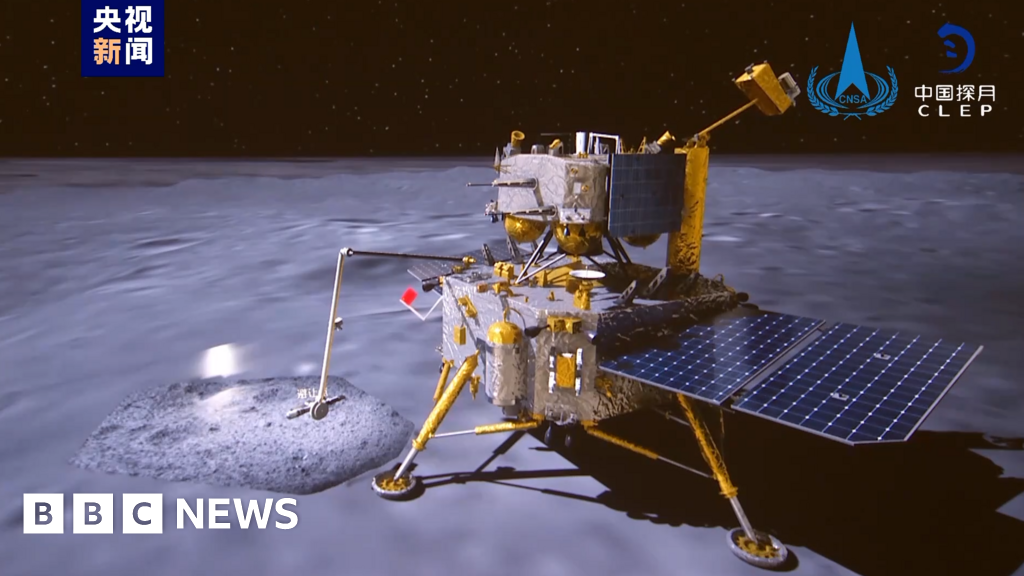China says its lunar probe has successfully taken off from the far side of the moon and has begun returning to Earth with the first samples collected from the area.
State media said a module of the Chang’e-6 spacecraft, named after the mythical Chinese moon goddess, successfully lifted off at 07:38 on Tuesday (23:38 GMT on Monday) and began its return journey.
The spacecraft landed near the moon’s south pole on Sunday, a world-first feat celebrated by the international scientific community.
China is the only country to land on the far side of the moon, having previously done so in 2019.
The China National Space Administration called the mission “an unprecedented feat in the history of human lunar exploration.”
That side of the Moon always faces away from Earth and is technically difficult to reach due to its rugged terrain and deep craters.
China’s mission aims to be the first country to bring back rock and soil samples from the region, which scientists say may be significantly different from rock formations on the near side of the moon.
State media released a video from the China Space Administration showing the unmanned robotic spacecraft extending a small arm and waving the Chinese flag after collecting the precious samples.
On Tuesday, Chinese state media announced the capsule’s successful takeoff, quoting the China National Space Administration as saying the probe’s ascent module had “lifted off from the lunar surface.”
“The mission withstood the high temperatures on the far side of the moon,” the space agency said.
After takeoff, the module then entered a “preset lunar orbit.”
The entire probe will return to its landing site in Inner Mongolia in about three weeks.
Scientists in China will first have the opportunity to analyze the rocks, with researchers around the world subsequently able to apply for the opportunity.
Scientists are excited about the samples China has been able to collect. The probe could extract some of the moon’s oldest rocks from a giant crater at the moon’s south pole.
The probe landed on Sunday in a giant crater called the Antarctic-Aitken Basin. The crater is one of the largest known in the solar system.
The landing was fraught with risk because it would be very difficult to communicate with the spacecraft once they reached the far side of the moon.
The Chinese aerospace department described the operation as having “many engineering innovations, high risks, and high difficulty.”
According to the CNSA, the mission’s goal is to collect about 2 kilograms (4.4 pounds) of material using drills and robotic arms.
Experts have previously told the BBC there was potential for new rocks.
Professor John Penne-Fisher, who specializes in lunar geology at the University of Manchester, said: “Everyone is really excited because we might be seeing these rocks that no one has seen before.”
He has previously analyzed moon rocks brought back by the U.S. Apollo missions and previous Chinese missions.
But he said the chance to analyze rocks from completely different regions of the moon could answer fundamental questions about how planets formed.
The moon’s South Pole is the next frontier for lunar exploration missions – an area countries are eager to learn about because of the likelihood of ice there.
Access to water would greatly increase the chances of successfully establishing a human scientific research base on the moon.
This is the second time China has launched a lunar sample collection mission.
In 2020, Chang’e-5 brought back 1.7 kilograms of material from a region called Oceanus Procellarum on the near side of the moon.
In 2019, China’s Chang’e 4 landed, becoming the first country to reach the far side of the moon.
China plans to conduct three more unmanned missions within a decade to search for water on the moon and study establishing a permanent base there.
Beijing’s broader strategic goal is to land Chinese astronauts on the moon by around 2030.
The United States also plans to return astronauts to the moon, and NASA plans to launch the Artemis-3 mission in 2026.

